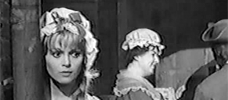Credits
Feature by: Adam Balz, David Carter, Katherine Follett, Leo Goldsmith, Chiranjit Goswami, Jenny Jediny, Andrew Schenker, Rumsey Taylor, and Megan Weireter
Posted on: 20 August 2008
Our conception of Russ Meyer’s work begins in defining the word Vixen. There are other terms Meyer appropriated in his singularly loquacious career – including Buxotic, Cantilevered, and his video nameplate, Bosomania – but Vixen is the one that most precisely exemplifies his preoccupations with sex, violence, and language. It is used in the title of three of his films: Vixen!, in 1968; Supervixens, 1975; and Beneath the Valley of the Ultra-Vixens, in 1979. Each of these films is anchored by the image of an exaggeratedly voluptuous woman, a living cartoon whose manner of speaking is often as embellished as her figure.
This woman is always of untenable interest to the red-blooded, middle-class American men in Meyer’s films. And in most each of them she remains dissatisfied and discriminated against, yet fearsomely powerful. It is this power that characterizes a woman in a Russ Meyer film—she is not used merely to excite, but equally to frustrate or domineer. Meyer’s women are eligibly cast according to their bust size, but breasts are indicators of power in a Russ Meyer film; his women are like an army of female praying mantises, poised to seduce and then kill. A Vixen is in turn one of cinema’s true icons, fully transcending her superficial utility to arouse.
Distinguishing Russ Meyer’s Vixens for their power and not for their obvious and insatiable sexual potency is a reasonably futile endeavor, I realize, although this is precisely one of the many aspects of his career we intend to clarify over the course of the next few weeks, in which we will be reviewing each of Meyer’s narrative films. And this notion of feminine power vis-à-vis objectified sexuality notwithstanding, there are other aspects of Meyer’s career and work that mark him as a man of immense, if undervalued creative ingenuity.
This difficulty in evaluation is enhanced by the scope of cinema peripheral to Meyer’s career. His first feature, The Immoral Mr. Teas, delighted more liberal audiences in 1959. At this time, and for the ensuing remainder of his career, Meyer’s films would remain outside the critical and popular mainstream, save for a brief contract with Fox in 1970 that produced two films—Beyond the Valley of the Dolls and The Seven Minutes. Despite this, many of his films were inordinately successful. Ultimately, this difficulty in firmly positing Meyer’s career within what is the most creatively potent era of cinema is exemplified in the hesitance and rarity in which he is cited as an auteur. His obsessions notwithstanding, he is a figure for whom the term is descriptive enough, but it pronounces an aspect of academicism that seems unbecoming of a man whose work screened more exclusively in drive-ins than in art houses.
In retrospect Russ Meyer seems less interested in cinema as an art than as a craft. And by this measure, he is as practiced and developed as any of his peers – having financed, produced, shot, written, directed, and edited most of his films entirely himself – only more of a common man than an academic in regard to his artistic and psychological preoccupations. His body of work – sixteen narrative films within the span of twenty years – is remarkable for its consistency in tone and narrative construction. Meyer’s films often begin impatiently (many even have a title song) with song or dance, and each is told in a peculiar, although assured, slang-laden language. From the narrator’s fatalistic preface in Faster Pussycat! Kill! Kill!:
Ladies and gentlemen, welcome to violence, the word and the act. While violence cloaks itself in a plethora of disguises, its favorite mantle still remains… sex. Violence devours all it touches, its voracious appetite rarely fulfilled. Yet violence doesn’t only destroy, it creates and molds as well. Let’s examine closely then this dangerously evil creation, this new breed encased and contained within the supple skin of woman. The softness is there, the unmistakable smell of female, the surface shiny and silken, the body yielding yet wanton. But a word of caution: handle with care and don’t drop your guard. This rapacious new breed prowls both alone and in packs, operating at any level, any time, anywhere, and with anybody.
Meyer’s films would become much more robust in their scope, to the point that they became almost abstractions—it is easy to envision them bulging from their sprockets as they were initially projected. For measure, the aforementioned Mr. Teas is comprised, simply, of a series of static, narrated scenarios that find the title character in a variety of morally compromising scenarios; and one of Meyer’s final films, Up!, contains Adolf Hitler and a Greek chorus, not to mention Meyer himself.
Perhaps it is futile to label Meyer an auteur, as the very term seems too staid and colorless to describe a man whose films are titled regularly with exclamation marks and in lettering shaped like genitalia. But there remains a propensity to critically evaluate Russ Meyer’s work, this despite the shot-on-a-weekend haste that characterizes many of his films—in description they’re less considered psychological and moral scenarios than they are relentless entertainments. But objective description – which, it should be noted, Meyer did a rather misleading job of himself in penning the copy on the VHS sleeves of his films – says little of the subversive feminism, slapstick wit, and moral/political ultimata that occurs in each of his films. They are entertainments, foremost, but nonetheless potent grounds for discussion.
One of Meyer’s most noteworthy creative collaborations began in the late 60s with Roger Ebert, who penned three of Meyer’s films, at least in part: Beyond the Valley of the Dolls, Up!, and Beneath the Valley of the Ultra-Vixens. In addition, he has written extensively on Meyer: his original review of Vixen!; an overview of Meyer’s work, in 1985; his review of Beyond the Valley of the Dolls; an interview with Meyer; and an obituary at the time of Meyer’s death in 2004. Ebert was kind enough to respond to some of our questions regarding Meyer and his collaborations with him.
NotComing.com:
Would you describe your first meeting with Russ?
Roger Ebert:
I wrote a letter praising the Wall Street Journal’s first article on Russ, and he called when he was in Chicago.
NCDC:
When did you first notice Meyer’s work receiving critical attention?
RE:
In 1959 or 1960, with the Leslie Fiedler article in Show magazine calling Mr. Teas the best comedy of the year.
NCDC:
Meyer’s first success as a filmmaker occurred in 1959 with the first of what I deem his “cinematic peep shows,” The Immoral Mr Teas. How influential or revolutionary were these films at the time?
RE:
I think Mr. Teas was a leap beyond the “peep shows” that preceded it. The professionalism was evident. In my hometown of Champaign-Urbana it played for more than a year.
NCDC:
In several instances in his films, Meyer associatively edits sex scenes with elements of sometimes outrageous discrepancy. In Finders Keepers, Lovers Weepers!, one tryst is cross-cut with a pair of Mennonites flying a kite, and in my favorite example, in Vixen!, one of the title character’s bedroom escapades is intercut with a verbal defense of Communism. It’s apparent in these examples that Meyer may be subverting the natural utility of a sex scene. Is this subversion something he knowingly engineered, or was he just being irreverent and playful?
RE:
He was irreverent and playful, and knew it. He found straightforward “sex scenes” boring—“they slow down the action.” The only example of an uninterrupted sex scene in his work is the lesbian scene in Vixen!.
NCDC:
You’ve written that Meyer’s productions may have resembled his experiences in WWII—that is to say, highly rehearsed and regimented. Do you think that the more objective aspects of the war – namely violence and oppression – may have inspired Meyer? For measure, his films contain numerous instances of hostility, enacted upon both sexes.
RE:
It was the production that evoked his war experiences. He was platoon leader, rousting people out of bed at dawn and summoning them to mess. Deploying his equipment and troops. Requiring total dedication. There are so many Nazis in his films because they represented a mocking triumph over the enemy. Most of the hostility between sexes is visited upon men, who, in his films, play the mindless sex objects.
NCDC:
How did working with Meyer in particular inform your career as a critic?
RE:
The daily experience at 20th Century-Fox was an education.
NCDC:
One the aspects I most admire in Meyer’s work is his language, which is even carried over to the descriptions on the VHS sleeves of his films. How conscientious were you in sustaining this language in your collaborations with him?
RE:
He wrote a language all his own. I never tried to write like that. He would add words and phrases.
NCDC:
Being a professional film critic at the time of the release of Beyond the Valley of the Dolls, how sensitive were you to the film’s initial reception?
RE:
It was all over the map. I would say, on balance, it was favorable. Even the negative reviews were dumbstruck. See John Simon’s attempt to describe the plot. As the credits promised, there had never been anything like it. It defied description and category. Today, it is possibly the most-revived film of its year.
NCDC:
Your remaining projects with Meyer – Up! and Beneath the Valley of the Ultra-Vixens – are both more freeform and kaleidoscopic than Dolls. What were the inspirations behind these films?
RE:
I only wrote some extra dialog for Up!. Beneath was inspired by Russ, who provided most of the story.
NCDC:
Would you describe your unmade projects with Russ—the Sex Pistols film Who Killed Bambi? and The Bra of God?
RE:
Bambi would have been a sensation, but the Pistols went broke. The Bra of God was never anything but a title. I wrote the unproduced screenplays Viva Foxy! and Son of Beyond the Valley of the Dolls.
NCDC:
In what films or filmmakers do you recognize Meyer’s influence?
RE:
None. Maybe a shade of Austin Powers.
Introduction by Rumsey Taylor
By Adam Balz, David Carter, Katherine Follett, Leo Goldsmith, Chiranjit Goswami, Jenny Jediny, Andrew Schenker, Rumsey Taylor, and Megan Weireter ©2008 NotComing.com
Reviews
-

The Immoral Mr. Teas / Eve and the Handyman
1959 / 1961 -

Lorna
1964 -

Fanny Hill
1964 -

Mudhoney
1965 -

Faster, Pussycat! Kill! Kill!
1965 -

Motor Psycho
1965 -

Mondo Topless
1966 -

Common-Law Cabin
1967 -

Good Morning and… Goodbye!
1967 -

Finders Keepers, Lovers Weepers!
1968 -

Vixen!
1968 -

Cherry, Harry & Raquel!
1970 -

Beyond the Valley of the Dolls
1970 -

The Seven Minutes
1971 -

Black Snake
1973 -

Supervixens!
1975 -

Up!
1976 -

Beneath the Valley of the Ultravixens
1979
We don’t do comments anymore, but you may contact us here or find us on Twitter or Facebook.



